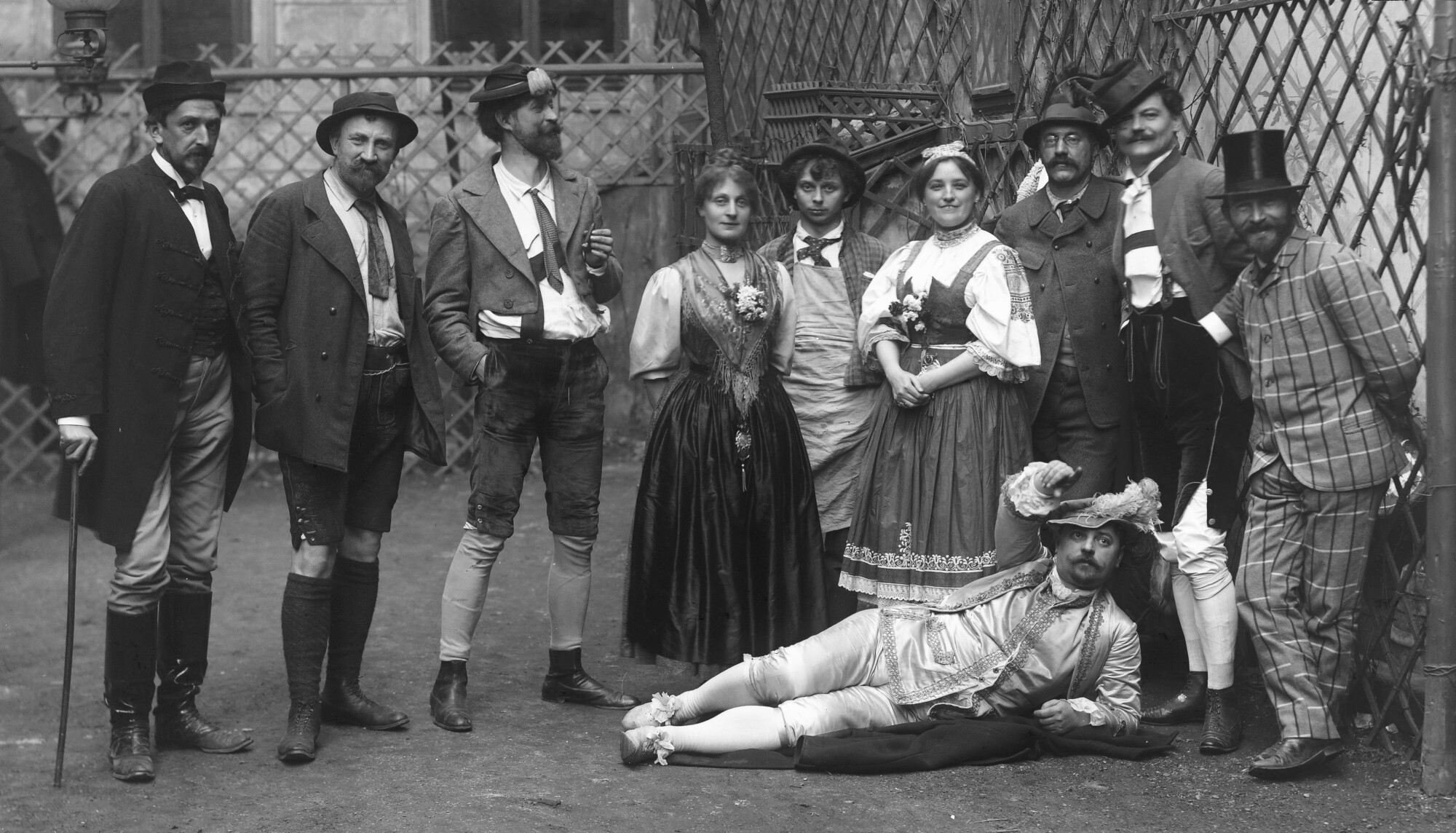Hagen Society

Members of the Hagengesellschaft in front of Café Sperl photographed by Moriz Nähr, around 1895
© Klimt Foundation, Vienna

Rudolf Bacher and Ernst Stöhr: Dedication of the Hagengesellschaft, 29.11.1888
© The ALBERTINA Museum, Vienna
The Hagengesellschaft [Hagen Society] was founded in 1880 and is considered the breeding ground of the Vienna Secession and the Hagenbund. This Viennese group included painters and sculptors, but also musicians, writers, scholars, and civil servants, who mostly met at the Café Sperl and the pub “Zum blauen Freihaus.”
On the occasion of the centenary of Emperor Joseph II’s accession to power, Viennese students organized a torchlight procession on 30 November 1880, after which some art students moved on to celebrate and spontaneously decided to meet weekly from now on. Initially, the meetings took place every Saturday afternoon in the immediate vicinity of the Imperial-Royal Academy of Fine Arts: first at the Café Schiller, later at the Café Sperl. In the evenings, they usually went to the nearby pub “Zum blauen Freihaus,” run by the art-loving innkeeper Joseph Haagen.
This loose association of painters, sculptors, musicians, writers, scholars, and civil servants was not an official association that had its own rules and statutes. The name was derived from the surname of innkeeper Haagen, although the second “a” in the name was soon dropped. As in the 1880s the society consisted mainly of young painters and sculptors, Ludwig Hevesi compared the group to the Parisian bohemians of Montmartre when he wrote in September 1905:
“It’s the little painterly private affairs of camaraderie at the studio and the pub, the uninhibited, spur-of-the-moment vagaries of the brush and the pencil at the coffeehouse table, in the back room of an inn, at the ‘cabaret’ of a Viennese Montmartre.”
A total of around 90 people can be identified by name as having belonged to the association from its foundation in 1880 to the 1940s. The core group included 20 to 25 members, the best known of whom were Rudolf Bacher, Adolf Boehm, Josef Engelhart, Franz Hohenberger, Eduard Kasparides, Friedrich König, Johann Viktor Krämer, Maximilian Lenz, Alfred Roller, Ernst Stöhr, and Leopold Stolba. Only a few members were photographers, among whom Moriz Nähr was probably the most prominent one. Max Widter and Johann Victor Krämer also frequently photographed the group in relaxed, informal poses and in costumes. As has been captured in some of the group photographs, the members shared above all a similar sense of humor, and there were frequent occasions to celebrate, such as when attending the legendary fancy dress balls and marksmen’s festivals at the Künstlerhaus.

Gschnasfest group of the Hagengesellschaft photographed by Moriz Nähr, around 1895
© Klimt Foundation, Vienna

Johann Victor Krämer: In the Café Sperl, 1888, Wien Museum
© Wien Museum
Soon the Hagen Society also met on weekdays to play cards, compose, make music, or draw. Drawing each other became a favorite pastime: the members often organized drawing competitions with humorous mottos, and the Café Sperl’s proprietor, Adolf Kratochwilla, collected the countless resulting caricatures in leather-bound albums. In 1905, a compilation of around 800 drawings entitled Ernstes und Heiteres [“Serious and Humorous Things”] from the Hagen Society portfolios went to the Albertina, which exhibited some of the works that same year.
Founding of the Secession and the Hagenbund
Many artists had joined the Cooperative of Visual Artists in Vienna (now Künstlerhaus) starting in the early 1890s. The young artists increasingly encountered difficulties within the Cooperative, especially with regard to its exhibition policy and how it embraced new ideas and foreign impulses, all of which led to conflicts. A separate group of artists coming from the Cooperative, the Hagen Society, and the so-called Siebener Club [Club of the Seven] formed, meeting at the Hotel Victoria. The Association of Austrian Artists – Secession was founded in 1897, its well-known founding members including Gustav Klimt, Kolo Moser, Carl Moll, Rudolf Bacher, Josef Engelhart, Johann Viktor Krämer, Alfred Roller, and Ernst Stöhr. The Secession's strict admission criteria in turn led to tensions among the artists. In 1899, some artists around Eduard Kasparides and Rudolf Konopa therefore founded the Künstlerbund Hagen of the Cooperative of Visual Artists of Vienna, which stood between the Künstlerhaus and the Secession. The tensions between the artists, who now belonged to separate associations, soon subsided, and the Hagen Society continued to meet for many years. Its members would hold an annual Christmas party at the Café Sperl until well into the 1940s.
Literature and sources
- Ludwig Hevesi: Die Albums der Wiener Hagengesellschaft. Albertina, in: Acht Jahre Sezession (März 1897–Juni 1905). Kritik – Polemik – Chronik, Vienna 1906, S. 509-512.
- Marian Bisanz-Prakken: Die Hagengesellschaft. Eine unbekannte Vorgeschichte der Secession, in: Marian Bisanz-Prakken (Hg.): Heiliger Frühling. Gustav Klimt und die Anfänge der Wiener Secession 1895–1905, Ausst.-Kat., Albertina (Vienna), 16.10.1998–10.01.1999, Vienna 1999, S. 35-57.
- Elisabeth Dutz: The Hagengesellschaft: Bohemia in Vienna, in: PhotoResearcher, Nummer 31 (2019), S. 112-133.
- L. A.: Das Blaue Freihaus. Ein Stammlokal der Wiener Künstler, in: Neues Wiener Tagblatt, 22.05.1903, S. 3-4.
- Adalbert Franz Seligmann: Die Hagen-Gesellschaft, in: Neue Freie Presse, 03.01.1931, S. 1-3.
- Uwe Schögl, Hans-Peter Wipplinger (Hg.): Moriz Nähr. Fotograf der Wiener Moderne / Photographer of Viennese Modernism, Ausst.-Kat., Leopold Museum (Vienna), 24.08.2018–29.10.2018, Vienna - Cologne 2018.
- Elisabeth Dutz: Moriz Nähr. Die Biografie, in: Uwe Schögl, Sandra Tretter und Peter Weinhäupl für die Klimt-Foundation (Hg.): Moriz Nähr (1859–1945). Fotograf für Habsburg, Klimt und Wittgenstein. Catalogue Raisonné, Wien (2021). www.moriz-naehr.com (05/22/2022).

